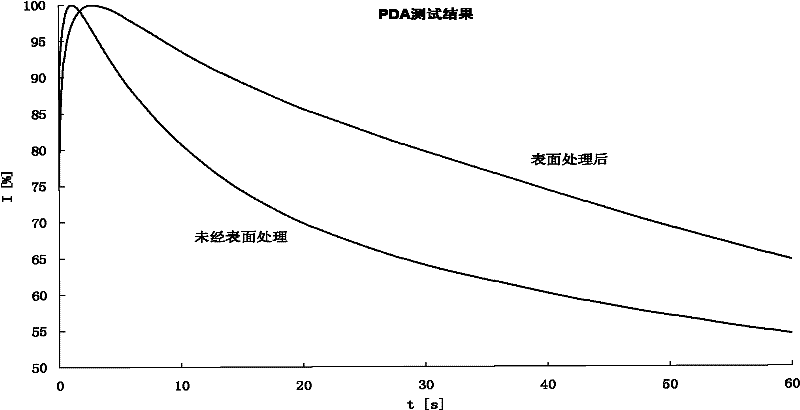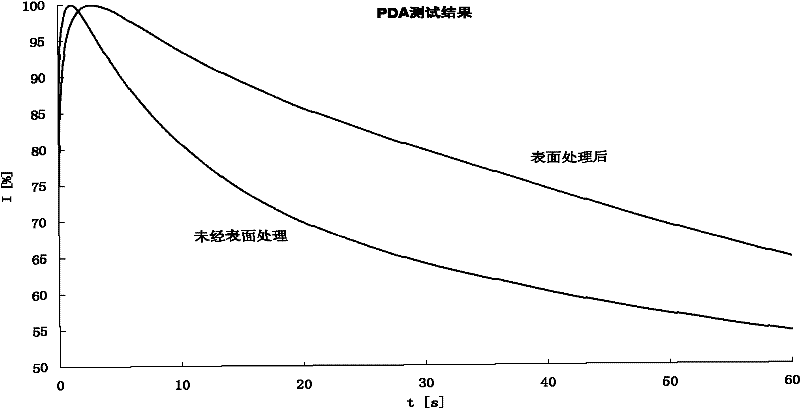Base paper for thermal transfer
A thermal transfer printing and pressure technology, which is applied in the direction of special paper, paper, papermaking, etc., can solve the problems of low economic and social benefits, insufficient water resistance, and low paper bulk, so as to improve transfer efficiency and The pass rate of printing, the effect of solving large-width printing wrinkles and reducing paper traction
- Summary
- Abstract
- Description
- Claims
- Application Information
AI Technical Summary
Problems solved by technology
Method used
Image
Examples
Embodiment 1
[0019] Embodiment 1: papermaking basis weight is 80gsm
[0020] 1. Pulping
[0021] 100% bleached chemical pulp is used, the amount of bleached chemical pulp of hardwood accounts for 70%, and the amount of bleached chemical pulp of coniferous wood accounts for 30%. During the pulping process, it is necessary to ensure that the fibers are separated as much as possible to avoid excessive cutting of fibers.
[0022] 2. Add chemicals
[0023] In order to ensure that the heat transfer base paper has sufficient water resistance and avoid excessive penetration of the expensive silica sol coating material into the base paper during the subsequent coating process, alkyl ketene dimer is added to the wet end with an amount of 10 kg / ton of paper, alkenyl succinic anhydride 1.5 kg / ton of paper, filler: precipitated calcium carbonate, ground calcium carbonate, etc., 150 kg / ton of paper, other functional additives are added according to demand.
[0024] 3. Surface sizing
[0025] Add 10 ...
Embodiment 2
[0028] Embodiment 2: papermaking basis weight is 100gsm
[0029] 1. Pulping
[0030] 100% bleached chemical pulp is used, the amount of bleached chemical pulp of hardwood accounts for 90%, and the amount of bleached chemical pulp of coniferous wood accounts for 10%. During the pulping process, it is necessary to ensure that the fibers are separated as much as possible to avoid excessive cutting of fibers.
[0031] 2. Add chemicals
[0032] In order to ensure that the heat transfer base paper has sufficient water resistance and avoid excessive penetration of the expensive silica sol coating material into the base paper during the subsequent coating process, alkyl ketene dimer is added to the wet end, with an amount of 8 kg / ton of paper, alkenyl succinic anhydride 1.6 kg / ton of paper, filler: precipitated calcium carbonate, ground calcium carbonate, etc., 140 kg / ton of paper, other functional additives are added according to demand.
[0033] 3. Surface sizing
[0034] Add 5 ...
Embodiment 3
[0037] Embodiment 3: papermaking basis weight is 200gsm
[0038] 1. Pulping
[0039] 100% bleached chemical pulp is used, the amount of bleached chemical pulp of hardwood accounts for 80%, and the amount of bleached chemical pulp of coniferous wood accounts for 20%. During the pulping process, it is necessary to ensure that the fibers are separated as much as possible to avoid excessive cutting of fibers.
[0040] 2. Add chemicals
[0041] In order to ensure that the heat transfer base paper has sufficient water resistance and avoid excessive penetration of the expensive silica sol coating material into the base paper during the subsequent coating process, alkyl ketene dimer is added to the wet end with an amount of 12 kg / ton of paper, alkenyl succinic anhydride 1.0 kg / ton of paper, filler: precipitated calcium carbonate, ground calcium carbonate, etc., 200 kg / ton of paper, other functional additives are added according to demand.
[0042] 3. Surface sizing
[0043] Add 15 k...
PUM
| Property | Measurement | Unit |
|---|---|---|
| Bulk | aaaaa | aaaaa |
Abstract
Description
Claims
Application Information
 Login to View More
Login to View More - R&D
- Intellectual Property
- Life Sciences
- Materials
- Tech Scout
- Unparalleled Data Quality
- Higher Quality Content
- 60% Fewer Hallucinations
Browse by: Latest US Patents, China's latest patents, Technical Efficacy Thesaurus, Application Domain, Technology Topic, Popular Technical Reports.
© 2025 PatSnap. All rights reserved.Legal|Privacy policy|Modern Slavery Act Transparency Statement|Sitemap|About US| Contact US: help@patsnap.com


